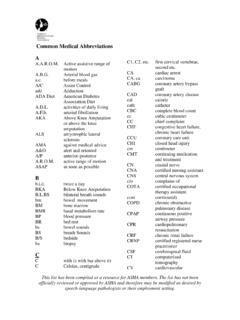Transcription of special tests le - scottsevinsky.com
1 Source: Palmer & Epler. Fundamentals of Musculoskeletal Assessment Techniques 2nd ed. 1998. lower extremity special tests Hip special tests Trendelenburg Test: a test for weakness of the gluteus medius muscle during unilateral weight bearing. Therapist is positioned behind patient to observe the pelvis. The patient assumes a unilateral stance on the test side extremity . A positive sign is indicated by the pelvis dropping toward the unsupported limb. Faber s (Patrick) Test: a test designed to alert the examiner to the possibility of hip pathology or SI joint dysfunction. The examiner places the test limb in flexion, abduction and external rotation so that the foot of the test limb rests on the patients opposite knee.
2 The examiner then passively presses the test limb toward the table while applying stabilizing counter pressure on the opposite ilium. The test is positive if there is noted pain in the back or the tested limb or if the tested limb remains in a plane above the opposite limb. This may indicate tightness of the hip flexors, adductors or joint capsule of the hip. Sign of the Buttock: a test for determining whether a patient s buttocks pain has its origin in the buttock as a local lesion or is referred from the hip, sciatic, nerve or hamstring muscles. The examiner performs an SLR test on the subject to the point of buttocks pain and notes the degree of hip flexion.
3 After returning the limb to a neutral position, the limb is subsequently again flexed at the hip but this time the knee is also flexed. If the amount of hip flexion is greater with the knee flexed as compared to extended Scouring (Qudarant) Test: a test for non-specific joint pathology. The examiner takes the test extremity and passively brings it into flexion. While applying an axial load the examiner then moves the extremity in quadrants. A positive test is indicated by clicking, crepitus or pain. Piriformis Test: a test to determine if tightness of the piriformis muscle is responsible for buttock pain or referred pain from the sciatic nerve.
4 The patient is positioned sidelying. The test limb is taken into flexion, adduction and internal rotation. A positive test is reproduction of gluteal pain or radicular symptoms in the distribution of the sciatic nerve. Thomas Test: a test to determine if a patient has tightness of the rectus femoris or iliopsoas muscles. The patient is positioned supine on the plinthe. The subject is then asked to bring both knees to their chest and to hold the untested limb with their hands. The examiner then passively lowers the test limb to the plinthe. If the limb remains up off the table, a hip flexor contracture is suspected.
5 To differentiate muscles, the examiner then passively extends the knee placing the rectus femoris on slack. If the test limb lowers to the table the rectus femoris is shortened. If the test limb remains off the table with the knee flexed the iliopsoas is shortened. Ely s Test: a test to determine if a patient has shortening of the rectus femoris muscle. The patient is positioned prone. The examiner passively flexes the knee of the test extremity . If the ipsilateral buttock rises off the plinthe the test is positive. Ober Test: a test to determine if a patient has tightness of the tensor fasciae latae or iliotibial band.
6 The subject is positioned sidelying with the test limb on top. The hip and knee of the limb closest to the plinthe should both be flexed to stabilize the patient. The uppermost limb is passively positioned into abduction and extension so the ITB passes over the greater trochanter. The knee may be either flexed or extended, but a greater stretch will be felt in extension. The examiner stabilizes the pelvis to prevent substitution and then allows the test limb to slowly adduct towards the table. A positive test is indicated by the test limb remaining off the table. Source: Palmer & Epler. Fundamentals of Musculoskeletal Assessment Techniques 2nd ed.
7 1998. Craig s Test a test for femoral anterversion. Patient is position prone on plinthe with knee bent to 90 . The greater trochanter is palpated and then the test leg is internally and externally rotated until the greater trochanter is positioned parallel to the table or feels to be protruding the greatest. The greater trochanter is then allowed to return to its normal position and the angle created is measured. A positive test is an angle > 15 . Sacroiliac Joint tests Usually the side where a patient reports their symptoms is the side of the dysfunction! Provocative tests are most reliable!
8 Standing FWD flexion Test: palpate PSISs while patient flexes FWD. Both PSIS should stay equal. If one side moves inferiorly with forward bending this may indicate hypomobility of that side. Gilette (Sacral Fixation) Test: With the patient standing, palpate S2 spinous process with one thumb and other on PSIS. With normal SI mobility the PSIS should rotate downward and the ischial tuberosity should move laterally as the hip flexes. Long Sitting (Supine Sit) Test: tests for the presence of an anterior or posterior innominate (rotation) at the SI joint. Begin by having the patient positioned supine with both legs bent up so that feet are resting on the plinth.
9 You may also ask them to perform a bridge to set their hips (Wilson-Barstow Maneuver). Once patient is comfortable straighten both legs while applying a slight distractive force on both malleoli. Note if one malleolus sits higher or lower than the opposite. For example, if a patient came in with a anterior innominate, in lying their ASIS would appear depressed while their PSIS would appear elevated. Essentially this moves their acetabulum inferiorly making it appear that their leg is longer. When the person moved into long-sitting the ASIS would appear elevated and the PSIS would appear depressed.
10 This would move the acetabulum superiorly making it appear that the leg is now shorter. If this were the outcome of the test the result would be a positive test for a anterior innominate. Treatment to Reverse Innominate Using a muscle energy technique we would begin to correct the anterior innominate by having the patient contract their right gluteal muscles to pull the pelvis posteriorly and reduce the rotation. If a posterior rotation occurred we would attempt to have the patient contract their iliacus, essentially their hip flexors to reverse the innominate. Supine Anterior Rotation leg appears long Posterior Rotation leg appears short Long Sitting Anterior Rotation leg appears short Posterior Rotation leg appears long Source: Palmer & Epler.



